
This big red Amaryllis has been with us for a few years and last summer we repotted it, removing a few of the small outer bulbs, and putting the big central bunch back into the same pot. When all the blooms are open there will be about 35-40 of them and it is quite spectacular. If you acquired a new Amaryllis bulb this winter keep it growing and move it outside in full sun, in the summer, and water and fertilize it regularly. It will replenish that bulb and probably start to grow offsets that will be big enough to bloom in a couple of years. Into the cool dark basement before the first frost and let it dry out and go dormant until early next year then return it to the light, water and warmth and it will reward you for your efforts.
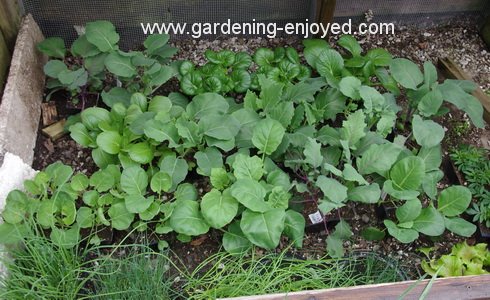
The heated cold frame is filling up with the cool season vegetables as they wait for the soil to dry enough to plant them or until I get the sub-irrigation containers ready for them. That should all happen next week when the weather is supposed to get warmer and more importantly, drier. The Pak Choi, Kohl Rabi, Cauliflower, Broccoli, Cabbage, Guy Lan. Etc. will thrive in the early, spring, cool weather and be feeding us by late May. We had the first Asparagus for dinner early this week, the earliest ever that I remember and we will enjoy it regularly until these other veggies are ready.
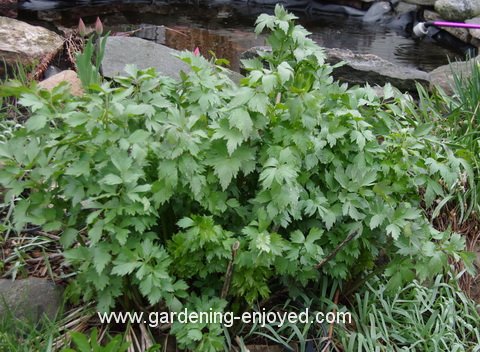
Lovage, this clump has been growing in this spot for years and I keep it because of its interesting tall foliage and yellow bloom. This spring we had some early lettuce so we cut a bunch of the Lovage to supplement the salad and it was quite delicious. Always knew that it was a good early salad green but have rarely used it, may do so more often now. Always something new to try.
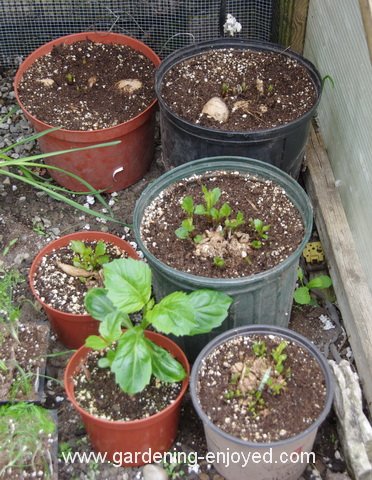
Dahlia tubers are always the deadest looking things when you buy them or bring them out from their winter storage. They are all brown and wrinkled with nary a hint of anything green showing up. The only hope is that those few, big, fat tubers, which apparently are edible although I have never tried them, will wake up and feed the very dormant growing point. They invariably do when I pot them up in late March. Here they are starting to grow nicely and the different varieties seem to wake up at different times. I just happened to walk by the rack of new Dahlias at the garden centre earlier this spring and a couple of them just seemed to jump into my cart. Those are the small containers in the picture. Happily they are both growing.
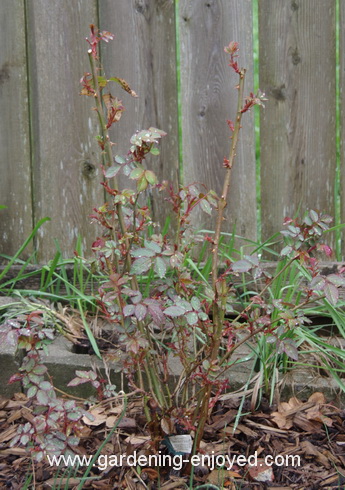
In the couple of warm days early this week we found our pruners and went looking for the Roses. We cut out all the thin spindly stems and then pruned the substantial ones down to four or five new shoots, cutting just above an outward facing one so that the bush would grow wider and bigger. Some of the taller ones, that are sort of climbers, are pruned further up depending on where the new growth is emerging. They will all, also, get a nice dose of fertilizer to keep them happy and growing.
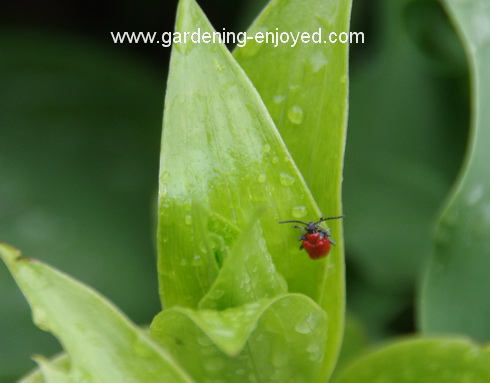
Well look who is already back trying to enjoy our garden. The very colourful but hungry Red Lily Beetle has apparently not drowned in all that soggy soil but has emerged and found some of my Lilies to start to feed on. This cute little adult will eat a few nice holes in the leaves and lay some eggs on the underside of those leaves. We work as diligently as possible to find and destroy those adults and eggs in an attempt to reduce the number of larva because they are the most voracious stage of these lily lovers. I need to prove that I love my Lilies more than they do, it’s an annual lover’s quarrel.
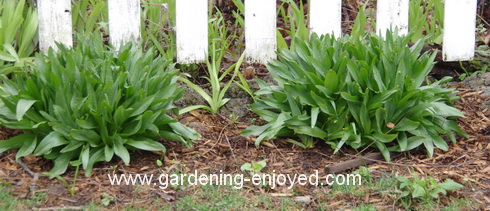 Against the west fence these big clumps of rich green leaves are growing prolifically and we cherish and encourage them because they are the spring foliage that produces the wonderful autumn Colchicum blooms. Each of those clumps now puts out 15-20 of those big, light, purple blooms in late September. This foliage will disappear by mid summer leaving the clumps of tall perennial grass growing between their spots.
Against the west fence these big clumps of rich green leaves are growing prolifically and we cherish and encourage them because they are the spring foliage that produces the wonderful autumn Colchicum blooms. Each of those clumps now puts out 15-20 of those big, light, purple blooms in late September. This foliage will disappear by mid summer leaving the clumps of tall perennial grass growing between their spots.
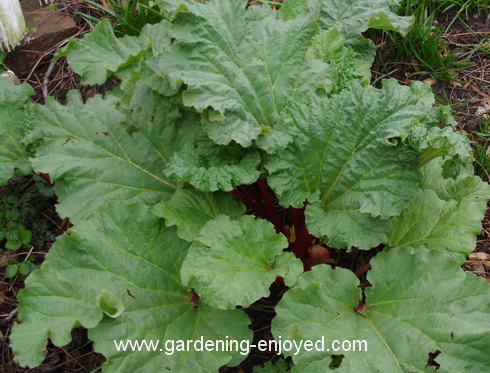
I can almost taste the pie as I stand and admire the rapid spring growth of the Rhubarb. It is a great perennial that bursts forth at the first sign of the warm, lengthening days. That rapid growth makes Rhubarb a hungry beast and it will be getting a significant shot of fertilizer in the next few days. In the old farm days a pile of rotted manure was applied to the Rhubarb patch but now I use a watering can filled with soluble fertilizer to get their appetite satisfied quickly.
The roads are pleasant to drive on this time of year, as I am travelling around sharing my various presentations with hort. societies, garden clubs and corporate presentations for lunch and learns. I would love to come and visit your organization. Check out my web page at Gardening-enjoyed.com for more details on topics and availability.
If you have any gardening questions just “reply” to this emailed
newsletter and I will attempt to answer them and then share them here if they are of wide interest.
Shayna Asks? Your garlic looks amazing... I missed out on growing some in the raised garden bed last fall. Can I plant them in spring instead? Or do I have a wait a whole 'nother year? Trying to see if I can cheat the system!
Ken Answers! Garlic usually will grow from a spring planting but the bulbs produced just won't be as big. Good Luck!
June Asks? The first - do you believe in waxing and waning planting (in sync with the moon phases)?
Secondly - I started my seeds about a week ago. I soaked the soil first, placed the seeds on top, then covered the seeds with dry soil.
I have the trays on a warming mat and they are covered with a clear plastic lid.
I haven't got round to spritzing the surface yet (they mostly appear dry) but I am already getting mould growing on the surface.
Ken Answers!
Many moons ago I was told by a professor at the U of Guelph that he never planted his Tomatoes until after the new moon at the end of May / early June and I have always, sort of, followed his advice.
I would spritz them as the seeds will get more moisture if it's available from below and above. If the mould you are seeing is just green then don't worry about it. If it's white and powdery then the spritzing should actually help.
Julie Asks? trying to find out if my hollyhock seeds are still viable. Would appreciate any tips you may have. I will probably purchase some new ones, but dislike tossing seeds, it amost feels like I'm destroying something!
Ken Answers!An easy germination test is to wrap the seeds in wet paper towel then put them in a plastic bag and keep them in a warm spot. If they are viable they should start to germinate in a week or so.
There seems to be some difference of opinion whether Hollyhock seeds need stratification,
a cold period, before they will germinate. Try some in the fridge in the wet towel for a week or three as well to test the theory.
|

 Against the west fence these big clumps of rich green leaves are growing prolifically and we cherish and encourage them because they are the spring foliage that produces the wonderful autumn Colchicum blooms. Each of those clumps now puts out 15-20 of those big, light, purple blooms in late September. This foliage will disappear by mid summer leaving the clumps of tall perennial grass growing between their spots.
Against the west fence these big clumps of rich green leaves are growing prolifically and we cherish and encourage them because they are the spring foliage that produces the wonderful autumn Colchicum blooms. Each of those clumps now puts out 15-20 of those big, light, purple blooms in late September. This foliage will disappear by mid summer leaving the clumps of tall perennial grass growing between their spots.





